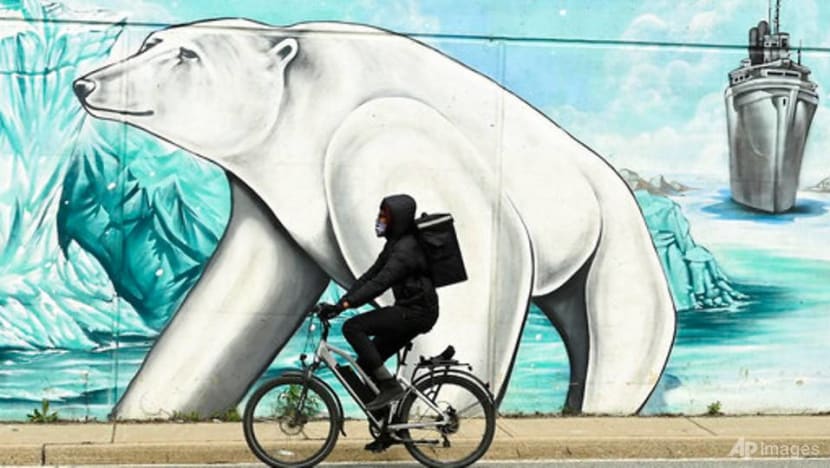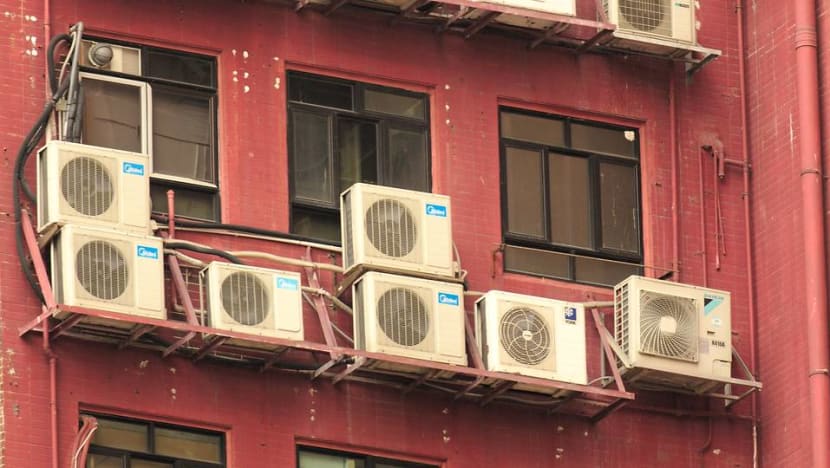commentary Commentary
Commentary: Moving to net-zero may not hurt as much as we think
Victory in the climate fight would amount to our day-to-day-living going on much as it did before, says the Financial Times’ Martin Sandbu.

A person rides their bicycle past a climate change-themed nature mural on Earth Day during the COVID-19 pandemic in Toronto, Thursday, April 22, 2021. (Nathan Denette/The Canadian Press via AP)
LONDON: In 1987, the world signed the Montreal protocol, agreeing to phase out the chlorofluorocarbons and related chemicals depleting the ozone layer.
At the time, CFCs were essential components in everyday necessities, such as refrigerants in fridges and propellants of aerosols. But the chemicals are now largely a thing of the past, and the ozone layer is on the mend.
The carbon transition is an incomparably larger challenge. Since the industrial revolution, our societies have been shaped by fossil energy. Our economic geography and even social relations have developed around the extraction, processing and combustion of hydrocarbons.
Emitting CO2 can seem as inevitable a consequence of economic and social life as breathing.
(Listen to James Trevelyan, engineer and founder of a personal air-conditioner company talk about how to keep the planet cool without harming it.)
The politics of climate change, too, are harder than the Montreal process, which produced results in record time from the scientific discovery of ozone depletion and with virtually unanimous international support.
Even so, global leaders’ resolve to shift the world to net-zero carbon is strengthening. US president Joe Biden’s climate summit last week brought forth more ambitious national targets, including from the US itself.
These targets need to be tighter still, and are only as good as the laws, regulations and tax reforms governments put in place to force economies off their carbon habit. But the direction of travel is unmistakable.
READ: Commentary: To everyone’s relief, US is back in the driver’s seat on climate change
Governments increasingly take the view that economies which fail to take climate action condemn themselves to being technological and business laggards once the transition takes hold. “We are convinced that there is an extraordinary benefit that awaits us,” as US climate envoy John Kerry told the Financial Times.
The message is to prepare for a fundamental transformation of our societies and our lifestyles.
READ: Commentary: Cooperation between US, China at global climate summit could yield significant benefits
LESSONS FROM MONTREAL
This is where we can learn from Montreal. Its most striking success is something we never think about: We still have fridges, air conditioners and spray cans. There is no consumer convenience we had to give up to save the ozone layer.

Once CFCs were banned, alternatives were found quickly. Perhaps the cost increased temporarily, but today’s products are if anything superior to those of the 1980s. The honest answer to what we had to sacrifice is: Nothing.
Could the same be true for the carbon transition?
We know how to generate electricity from carbon-free sources, so everything electrically powered is compatible with a net-zero economy. The technology exists for zero-emissions road transport. The right financial incentives can trigger very quick take-up, as shown by Norway where the majority of new cars sold are emissions-free.
While more progress is needed for hydrogen-powered goods freight, it is clear that a carbon-neutral world is compatible with car habits practically indistinguishable from today (but with cleaner air in cities). In time, shipping, too, can be powered by carbon-free energy.
READ: Commentary: Suez Canal incident reveals why global trade depends heavily on shipping with few alternatives
What about flying? Short-haul flights can be replaced by train travel or eventually zero-emissions planes.
Such solutions currently seem impossible for long haul. That need not mean an end to intercontinental travel – just an end to frequent, mass intercontinental flights. It may cost a lot more to travel across the globe, but fewer such trips will be taken and when they are, travellers will stay away for longer.
That is not a radically different world. It is what long-distance travel was like until the 1980s.
READ: Commentary: Flights to nowhere raise bigger questions about Singapore Airlines’ future
In construction, cement and steel are highly carbon-intensive. But they are not the only possible building materials. Timber buildings with over 20 storeys have already been erected.
Allow for the development of green steel production, and there is little reason to think that we cannot build and live emissions-free in ways that feel quite similar to today.

Finally, the existence of negative net emissions technologies means some activities can be maintained in a net-zero world, even if it proves impossible to make them entirely carbon neutral.
GARGANTUAN CHALLENGE AHEAD
The point is not to underplay the challenge ahead of us, which is gargantuan. The carbon transition requires bold steps in politics and policy, and for people and businesses to change their behaviour from fossil-powered to carbon-neutral options.
The cost of doing so must be reduced for the poorest, ideally by redistributing carbon taxes as “carbon dividends”.
But if – hopefully when – we do this, the result need not feel like a revolution. It is failure that could upend catastrophically the normality most people aspire to.
Unlike in a war, victory in the climate fight would amount to our day-to-day-living going on much as it did before. That is a message it would help to hear more often.










